
| [Home] | [Books] | [Forum] | [Author] | [All Essays] |
A CRITICAL COMMENTARY ON CHAOS THEORY AND FRACTAL GEOMETRY The Analysis of a Snowflake Charles William Johnson With the combination of chaos theory and fractal geometry, many scientists perceive a strange order where they see no apparent order. The chaologists, as they call themsleves, believe that certain events in reality reveal patterns, which are inherently unpredictable.To them predictability represents the cornerstone of science. They hold that if one cannot predict the behaviour of a spacetime event as of its existence, then that is not scientific. The patterns that chaologists and fractal geometrists have singled out for study are intriguing. Such examples would seem to show that nature works in strange and chaotic ways at times. However, we should take issue with the proposition that spacetime events are unpredictable or incomprehensible. We have chosen the case of a single snowflake in order to understand the conditions of existence of the spacetime events which most chaologists and fractal geometrists seem to be ignoring in their analyses. They are limiting their analysis of spacetime events to the visible and superficial patterns produced by spacetime events themselves. In other words, they are ignoring or avoiding the conditions of existence which produce the observed patterns. By ignoring the conditions of existence of the perceived patterns, it becomes impossible to explain the reason for being of the patterns, muchless of the events themselves. Furthermore, the examples offered to prove their case regarding fractals, such as the book by John Briggs (FRACTALS,THE PATTERNS OF CHAOS, A Touchstone Book, New York, 1992, 192pp.), refers to such distinct levels, moments and relations of spacetime events, that the very postulates of spacetime/movement themselves are unclear. We shall examine one specific example which Briggs offers in order to understand how we might examine the conditions of existence of the spacetime events, and not just the mere fact that they do exist. For our analysis we have chosen, the very snowflake that Briggs shows in his book on fractals. Since each snowflake is different, unique from all other snowflakes, then, if we are able to explain the conditions of exitence of one snowflake, then this exercise should hold for all other snowflakes. In other words, we do not consider it necessary to analyze each and every snowflake that ever existed! Such a task is quite impossible. Before we enter the analysis of the snowflake, let us look at the main characteristics which chaologists and fractal geometrists mean by the word‑concepts of chaos and fractals, according to the author Briggs. Chaotic and fractal events refer to: entropy or disorder; chaos; non‑linear events; patterns and symmetry at times; holism; fractal scaling; self‑similarity; fractal structure; events that appear to be iterating the equation; uncertainty; etc. All of these concepts are explained clearly in Briggs' essay on fractals. In a sense, he is concluding that fractals exist alongwith chaos when the events are extremely sensitive to their conditions of existence at the very initial stages of their existence. We should point out that never are these conditions of existence of the chosen events ever addressed directly by Briggs. Even though the fractal geometrists and chaologists appear to be recognizing the existence of certain patterns and symmetry in some events, basically they are merely pointing out strange looking patterns and lop‑sided symmetries revealed visually in the events, whereby a pattern can be discerned of some kind. Chaos then is not total chaos, but simply appears to be chaotic. The chaologists and the fractal geometrists are looking at the self‑defined strange patterns and then comparing these patterns against their ideal concepts of what symmetry and order represent, and then concluding that some spacetime events are not symmetrical and unordered. When we came upon the example of the snowflake, as we reviewed the many different examples offered in Briggs' book, we realized that a snowflake reflects a definite pattern which, to a certain point can be comprehended: it will be six‑fold as they say; it will be made of ice crystals; it will have ribs and webs; and it will be pleasing to the eye, among other things. Now, exactly which final and specific shape each will take cannot be predicted (said beforehand) until one observes the specific snowflake ‑‑‑after it has gone through its creation, its particular conditions of existence. Now, why is that? Simply because of the conditions of existence of the snowflake, the manner in which a snowflake comes into existence ‑‑‑particular relationship of water‑vapor, wind and air, and the cold temperature, and the particular way in which these conditions come together for each snowflake; conditions which are never repeated obviously. There is no other reason. But, we should answer what the conditions of existence of the snowflake are in order to better understand this simple answer. By examining a single snowflake, completely removed from its environment and conditions of existence, we can concentrate upon the patterns observed and possibly conclude that they do resemble the definition of fractals, because their pattern appears to be strange. But this does not tell us very much. We shall analyze the snowflake from the perspective of spacetime/movement, whereby we shall consider the different space‑time/movement coordinates of the snowflake itself. We shall analyze some of its aspects (= space coordinates), moments (=time coordinates), and relations (= movement/motion coordinates). This proceedure is based on the fact that reality is spacetime/movement and manifests itself in specific matter‑energy events. In order to know a particular matter‑energy event (such as a snowflake), one must apprehend and discern all> of the aspects‑moments/relations (= spacetime/movement coordinates) of a particular event of matter‑energy. FIGURE 1: THE SNOWFLAKE 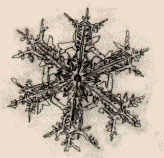 The snowflake that Briggs presents us on page 95 of his book has six horizontal axes running along the ribs of the frozen water‑vapor crystal. FIGURE 2: THE SIX HORIZONTAL AXES OF A SNOWFLAKE  The snowflake also one vertical axis running perpendicullarly through its centerpoint: FIGURE 3: THE SINGLE PERPENDICULAR AXIS OF A SNOWFLAKE  The possibilities of the snowflakes spinning in all directions on its seven distinct axes represents one condition of its existence. Another condition of existence of the snowflake regards the amount of water‑vapor that makes up its mass and weight. The distribution of its body weight will be in relation to its spin, its falling towards the earth, the earth's gravity, the wind resistance, etc. Another factor that will influence its shape will be the direction(s) of the wind and its velocity. The cold temperature will be another factor that comes into play for shaping the patterns in the snowflake. The ultimate speed and swirling of the snowflake throughout its fall will contribute to the pattern of the snowflake. The direction travelled by the snowflake at every turn on its trip downward will be another condition of its existence. The pull of gravity on the amount of water‑vapor mass and its constantly moving distribution in the snowflake will determine also the relationship to the wind and cold. Another condition of its existence will be the flip‑flop movement that the snowflake will take on during its fall to earth; and evidently its rising on the wind. In other words, its every movement will come into play to design its unique pattern. It is understandable that no two snowflakes travel the SAME spacetime coordinates EVER, as each path is unique and distinct, then each pattern will be a result of that unicity; just as each human being is unique. Furthermore, it is a characteristic of spacetime/movement events that no two spacetime/movement events can occupy the same spacetime/movement coordinates ever. In other words, each spacetime/movement event is exclusive of all the other spacetime/movement events. This is a feature of matter‑energy events as we know them. All of these cited factors, alongwith their intricate and indiscernable relationships, determine the particular shape a specific snowflake might take. In as much as it is impossible to determine each specific relationship of all of these factors, one cannot possibly foresee or predict so to speak the outcome. But, again, this is not a specific characteristic of snowflakes or so‑called fractals, nor does it imply any idea concept of chaos, but merely represents and reflects the relationships of spacetime/movement events, of matter‑energy itself in its particular forms and manifestations. What is so‑called chaotic or fractal is simply produced by the uncountable levels‑moments/relations involved in each particular event of matter‑energy. In fact, all of reality, spacetime/movement, exists in this manner. We can predict (so to speak) certain levels of spacetime events. This we know. For example, we know more or less the conditions for snow to exist. We are not always sure when it will fall, nor in what specific quantities; hence the headaches for the weather forecasters.> Upon reviewing in detail the snowflake, we can see that it consists of a rib structure: FIGURE 4: THE SNOWFLAKE'S RIB STRUCTURE FORMED BY THE FLOW OF THE WATER‑VAPOR
Between the ribs of the snowflake, we can observe spaces which were evidently occupied by a sheet of ice, a very thin sheet at that, which formed a web. These webs make it possible for the snowflake to become aerodynamic and "float" slowly towards the earth, evidently falling faster as the webs disappear and wear off. FIGURE 5: THE WEBS OF A SNOWFLAKE  The snowflake would appear to be then complete were we to draw the visible lines of the rib and web structure as suggested by its own apparent pattern. FIGURE 6: THE RIB AND WEB STRUCTURE OF THE SNOWFLAKE AS SUGGESTED BY ITS PATTERN  The direction that the water vapor appears to travel along the rib structure is as follows: FIGURE 6a: THE WATER‑VAPOR FLOW ALONG THE RIB STRUCTURE OF THE SNOWFLAKE 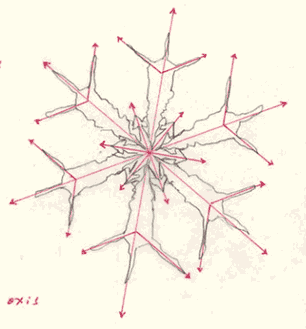 Furthermore, we can understand the water‑vapor flow along both the rib structure and the web spaces as follows:> FIGURE 7: THE SNOWFLAKE' WATER‑VAPOR FLOW ALONG THE RIB AND WEB STRUCTURE  It can be suggested that at its inception, this particular snowflake probably had a more widespread rib structure, such as the one shown in the following drawing: FIGURE 8: THE RECONSTRUCTED RIB STRUCTURE OF A SNOWFLAKE
It is easy to observe that the hard ice crystal rib structure is by no means chaotic or fractal or strange. Neither is the web structure of the ice crystals strange, chaotic or fractal. Fractal and chaotic analyses take the end‑product (the falling/fallen snowflake), towards the end of its journey and merely dwells on the pattern of the ice crystal itself. Such analyses do not offer a complete picture of the spacetime/movement coordinates of the snowflake along its entire journey. We may now offer the snowflake in its reconstructed form which it probably had at the beginning of its journey, when it began its descent towards earth. FIGURE 9: A RECONSTRUCTION OF THE WEB STRUCTURE OF THE SNOWFLAKE AT ITS INCEPTION  The water vapor's centrifugal movement (outwards from its central perpendicular axis) reveals a flow of water run‑off towards its outter edges. We may observe distinct kinds of water flow that make up the pattern of the ice crystal as such, where it reveals as we have seen one pattern on the rib structure and another on the web structure. The relationships involved here are many, as we stated earlier, but basically we are seeing the result of wate vapor, air currents and cold weather coming into contact with one another to form the snowflake. FIGURE 10: THE WATER‑VAPOR SPIN‑OFF OF THE SNOWFLAKE  As we observe the details of the rib structure, we can observe tiny arrows that reflect the flow of the water vapor, within the rib structure flowing from the snowflake's center point. FIGURE 11: THE SNOWFLAKE'S WATER‑FLOW PATHS AS OF THE CENTRIFUGAL FORCE MOVEMENT 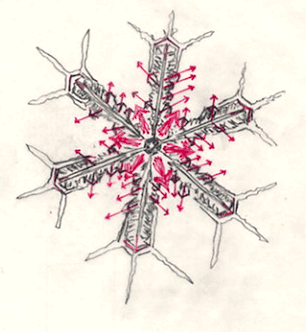 Now let us observe the internal dynamics of the snowflake's water vapor paths as against the web structure and the tips of the main axes, where we see meet wind resistance pressure with water vapor pressure. FIGURE 12: WATER‑VAPOR PRESSURE MEETING WIND‑RESISTANT PRESSURE IN THE SNOWFLAKE  We may observe now the wind pressure against the ice crystal: FIGURE 13: WIND PRESSURE AGAINST THE ICE CRYSTALS OF THE SNOWFLAKE  Now, let us look at the example of when wind, water‑vapor and cold weather come together in the earth's atmosphere under certain conditions to form snowflakes: FIGURE 14: THE ABSTRACTED FLOW OF WIND AND WATER‑VAPOR IN THE FORMATION OF A SNOWFLAKE
In order to understand completely the spacetime/movement coordinates of such an event as a snowflake, one would have to conceive of the snowflake as a time‑process. This would involve understanding that a snowflake is not a fractal/chaotic isolated event; it represents part of a process: the circulation of water on our planet. In other words it reflects one specific moment of that cycle of water circulation.> One would have to ask how the water‑vapor got up in the atmosphere to begin with! One would then have to realize that a cycle of water circulation on a time scale would involve distinct forms of water as such: WATER‑VAPOR SNOW HAIL FREEZING RAIN RAINDROPS WATER ETC. One would then have to proceed to analyze all of the conditions of existence of each specific event of this time process. In other words, one would have to discern and understand the wind, the water form, the temperature conditions, etc., of each one of these stages of the circulation of water on our planet. To single out one particular matter‑energy event (such as a snowflake or an ice crystal) and call it chaotic, fractal, unpredictable, a strange pattern, self‑similar (in other words "it looks like itself!"), offers little to the construction of knowledge about spacetime/movement and its uncountable forms and manifestations of matter‑energy. As we have attempted to demonstrate through the analysis of specific levels and aspects of space, particular moments and processes of time, and certain relations and structures of movement, the snowflake can obviously be explained regarding its conditions of existence. It is a question, as we have done here, of reviewing each particular spacetime/movement coordinate and event of the snowflake and its relationships with other spacetime/movement events. Undoubtedly, it is unnecessary and even impossible to analyze the snowflake in all of its spacetime/movement coordinates; we have chosen only a few abstracted levels to exemplify our point. With this brief analysis, however, we have attempted to draw attention to the possibility of analyzing such so‑called chaotic and fractal events as of their spacetime/movement coordinates.
©1992-2011 Copyrighted by Charles William Johnson. Reproduction Prohibited. This essay together with its drawings were written and made public in 1992. The drawings have appeared by themselves without the analytical text on the Internet for many years now. This is the first time that the text of this essay is appearing published on the Internet. Consider that this essay was written in 1992, published by Earth/matriX in 1993, long before much of the recent research and photographs about the nature of snowflakes. This essay represents a theoretical exercise in understanding the limitations of so-called chaos theory. |
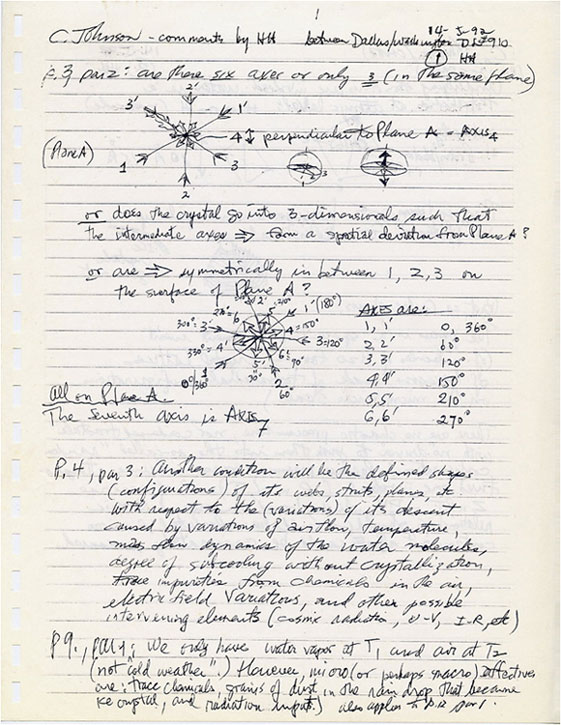 |
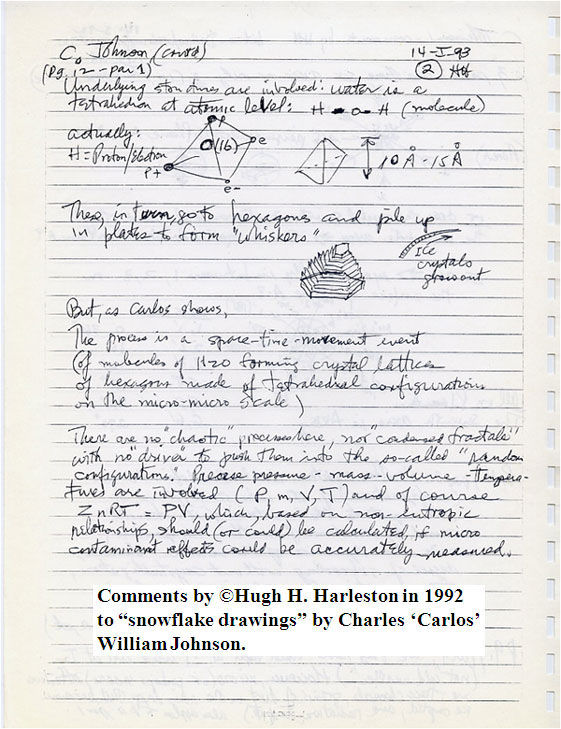 |
| [Home] | [Books] | [Forum] | [Author] | [All Essays] |
Earth/matriX:
Science in Ancient Artwork Series ISSN-1526-3312
©2011 Copyrighted by Charles William Johnson. All rights reserved.
Reproduction prohibited.
The text and all images of this website are copyright protected.